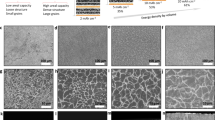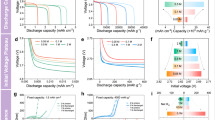Abstract
Chemical energy storage using batteries will become increasingly important for future environmentally friendly (‘green’) societies. The lithium-ion battery is the most advanced energy storage system, but its application has been limited to portable electronics devices owing to cost and safety issues1. State-of-the-art LiFePO4 technology as a new cathode material with surprisingly high charge–discharge rate capability has opened the door for large-scale application of lithium-ion batteries such as in plug-in hybrid vehicles2,3,4,5. The scientific community has raised the important question of why a facile redox reaction is possible in the insulating material6,7,8,9,10,11,12,13,14. Geometric information on lithium diffusion is essential to understand the facile electrode reaction of LixFePO4 (0<x<1), but previous approaches have been limited to computational predictions15,16. Here, we provide long-awaited experimental evidence for a curved one-dimensional chain for lithium motion. By combining high-temperature powder neutron diffraction and the maximum entropy method, lithium distribution along the [010] direction was clearly visualized.
This is a preview of subscription content, access via your institution
Access options
Subscribe to this journal
Receive 12 print issues and online access
$259.00 per year
only $21.58 per issue
Buy this article
- Purchase on SpringerLink
- Instant access to full article PDF
Prices may be subject to local taxes which are calculated during checkout




Similar content being viewed by others
References
Armand, M. & Tarascon, J. M. Issues and challenges facing rechargeable batteries. Nature 414, 359–367 (2001).
Padhi, A. K., Nanjundaswamy, K. S. & Goodenough, J. B. Phospho-olivines as positive-electrode materials for rechargeable lithium batteries. J. Electrochem. Soc. 144, 1188–1194 (1997).
Yamada, A., Chung, S. & Hinokuma, K. Optimized LiFePO4 for lithium battery cathodes. J. Electrochem. Soc. 148, A224–A229 (2001).
Huang, H., Yin, S.-C. & Nazar, L. F. Approaching theoretical capacity of LiFePO4 at room temperature at high rates. Electrochem. Solid-State Lett. 4, A170–A172 (2001).
Chung, S. Y., Bloking, J. T. & Chiang, Y. M. Electronically conductive phospho-olivines as lithium storage electrode. Nature Mater. 1, 123–128 (2002).
Delacourt, C., Poizot, P., Tarascon, J. M. & Masquelier, C. The existence of a temperature-driven solid solution in LixFePO4 for 0<x<1. Nature Mater. 4, 254–260 (2005).
Yamada, A., Koizumi, H., Sonoyama, N. & Kanno, R. Phase change in LixFePO4 . Electrochem. Solid-State Lett. 8, A409–A413 (2005).
Yamada, A. et al. Room-temperature miscibility gap in LixFePO4 . Nature Mater. 5, 357–360 (2006).
Meethong, N., Huang, H.-Y. S., Carter, W. C. & Chiang, Y.-M. Size-dependent lithium miscibility gap in nanoscale Li1−xFePO4 . Electrochem. Solid-State Lett. 10, A134–A138 (2007).
Maxisch, T., Zhou, F. & Ceder, G. Ab initio study of the migration of small polarons in olivine LixFePO4 and their association with lithium ions and vacancies. Phys. Rev. B 73, 104301 (2006).
Ellis, B., Perry, L. K., Ryan, D. H. & Nazar, L. F. Small polaron hopping in LixFePO4 solid solutions: Coupled lithium-ion and electron mobility. J. Am. Chem. Soc. 128, 11416–11422 (2006).
Chen, G., Song, X. & Richardson, T. J. Electron microscopy study of the LiFePO4 to FePO4 phase transition. Electrochem. Solid-State Lett. 9, A295–A298 (2006).
Laffont, L. et al. Study of the LiFePO4/FePO4 two-phase system by high-resolution electron energy loss spectroscopy. Chem. Mater. 18, 5520–5529 (2006).
Allen, J., Jow, T. & Wolfenstine, J. Kinetic study of the electrochemical FePO4 to LiFePO4 phase transition. Chem. Mater. 2108–2111 (2007).
Morgan, D., der Ven, A. V. & Ceder, G. Li conductivity in LixMPO4 (M=Mn, Fe, Co, Ni) olivine materials. Electrochem. Solid-State Lett. 7, A30–A32 (2004).
Islam, M., Driscoll, D., Fisher, C. & Slater, P. Atomic-scale investigation of defects, dopants, and lithium transport in the LiFePO4 olivine-type battery material. Chem. Mater. 17, 5085–5092 (2005).
Mizushima, K., Jones, P. C., Wiseman, P. J. & Goodenough, J. B. LixCoO2 (0<x<1): A new cathode material for batteries of high energy density. Mater. Res. Bull. 15, 783–789 (1980).
Yazami, R. & Touzain, P. A reversible graphite-lithium negative electrode for electrochemical generators. J. Power Sources 9, 365–371 (1983).
Nagaura, T. & Tozawa, K. Development of rechargeable lithium batteries. II. Lithium ion rechargeable battery. Prog. Batteries Solar Cells 9, 209–217 (1991).
Dodd, J., Yazami, R. & Fultz, B. Phase diagram of LixFePO4 . Electrochem. Solid-State Lett. 9, A151–A155 (2006).
Dodd, J., Halevy, I. & Fultz, B. Valence fluctuations of 57Fe in disordered Li0.6FePO4 . J. Phys. Chem. C 111, 1563–1566 (2007).
Gull, S. F. & Daniel, G. J. Image reconstruction from incomplete and noisy data. Nature 272, 686–690 (1978).
Collins, D. M. Electron density images from imperfect data by iterative entropy maximization. Nature 298, 49–51 (1982).
Schotte, K.-D., Schotte, U., Bleif, H.-J. & Papoular, R. Maximum-entropy analysis of the cubic phases of KOH and KOD, NaOH and NaOD. Acta Crystallogr. A 51, 739–746 (1995).
Shikanai, F. et al. Neutron powder diffraction study on the high-temperature phase of K3H(SeO4)2 . Physica B 385–386, 156–159 (2006).
Yashima, M., Itoh, M., Inaguma, Y. & Morii, Y. Crystal structure and diffusion path in the fast lithium-ion conductor La0.62Li0.16TiO3 . J. Am. Chem. Soc. 127, 3491–3495 (2005).
Yashima, M. et al. Conduction path and disorder in the fast oxide-ion conductor (La0.8Sr0.2)(Ga0.8Mg0.15Co0.05)O2.8 . Chem. Phys. Lett. 380, 391–396 (2003).
Izumi, F. & Ikeda, T. A Rietveld-analysis program RIETAN-98 and its applications to zeolites. Mater. Sci. Forum 321–324, 198–205 (2000).
Momma, K. & Izumi, F. VESTA: A three-dimensional visualization system for electronic and structural analysis. J. Appl. Crystallogr. 41, 653–658 (2008).
Acknowledgements
The authors would like to thank Y. Yamaguchi, M. Yonemura, H. Koizumi and K. Nemoto for their support in the neutron diffraction experiments. This work was financially supported by the Ministry of Education, Culture, Sports, Science and Technology of Japan, through a Grant-in-Aid for Scientific Research (A) No. 19205027, and the New Energy and Industrial Technology Development Organization (NEDO). JSPS fellowship No. 19.10259 is greatly appreciated by S.N.
Author information
Authors and Affiliations
Contributions
S.N. carried out sample preparation, room-temperature neutron diffraction experiments at VEGA, structure analysis, MEM analysis and all of the related work in supporting information, G.K. carried out sample preparation and the high-temperature neutron diffraction (HT-ND) experiments at HERMES, K.O. set up the equipment for the HT-ND experiments at HERMES, R.K. co-supervised the project, M.Y. supervised the HT-ND experiments at HERMES, A.Y. conceived, supervised and coordinated the whole project. S.N. and A.Y. wrote the manuscript.
Corresponding author
Supplementary information
Supplementary Information
Supplementary Figures S1–S6 and Tables S1 & S2 (PDF 3334 kb)
Rights and permissions
About this article
Cite this article
Nishimura, Si., Kobayashi, G., Ohoyama, K. et al. Experimental visualization of lithium diffusion in LixFePO4. Nature Mater 7, 707–711 (2008). https://doi.org/10.1038/nmat2251
Received:
Accepted:
Published:
Issue Date:
DOI: https://doi.org/10.1038/nmat2251



